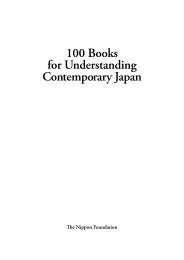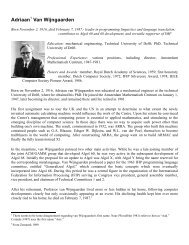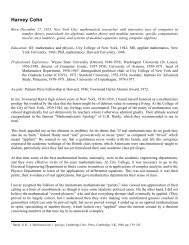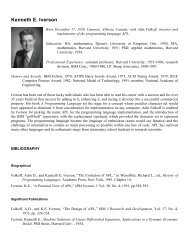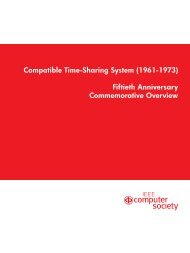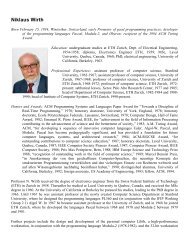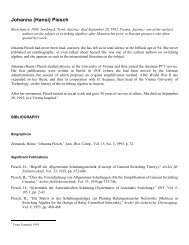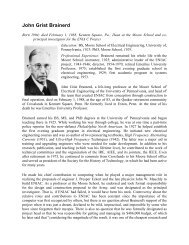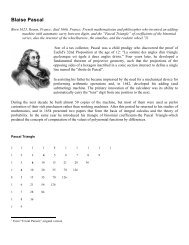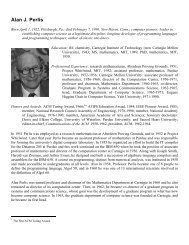Arthur Walter Burks
Arthur Walter Burks
Arthur Walter Burks
You also want an ePaper? Increase the reach of your titles
YUMPU automatically turns print PDFs into web optimized ePapers that Google loves.
<strong>Arthur</strong> <strong>Walter</strong> <strong>Burks</strong>Born October 13, 1915, Duluth, Minn.; one of the principal designers of the ENIAC, workingwith John Mauchly and J Presper Eckert; with Herman H. Goldstine, helped John vonNeumann develop the logical design of the Institute for Advanced Study (IAS) computerthevon Neumann architecture.Education: BA, mathematics and physics, DePauw University, 1936;PhD, philosophy and logic, University of Michigan, 1941.Professional Experience: instructor, Moore School of ElectricalEngineering, 1941-1946; Institute for Advanced Study, 1946, andsummers 1947, 1948; University of Michigan, 1946-present, nowprofessor emeritus of philosophy, and of electrical engineering andcomputer science.Honors and Awards: DSc (Hon.), DePauw University, 1973; Russel Lecturer, University ofMichigan, 1977-1978; IEEE Computer Pioneer Award, 1982.<strong>Arthur</strong> W. <strong>Burks</strong> earned his BA in mathematics and physics from DePauw University in 1936,and his PhD in philosophy from the University of Michigan in 1941. He became an instructor atthe Moore School of Electrical Engineering in the fall of that year and did war research on minesweeping,radar antennas, and the ENIAC. He left the Moore school after the ENIAC wasdedicated and then worked at the Institute for Advanced Study with John von Neumann. Therehe joined with John von Neumann and Herman H. Goldstine to write one of the most influentialreports in the field of computing, “Preliminary Discussion of the Logical Design of an ElectronicComputing Instrument,” which is mentioned in the biographies of many other pioneers.<strong>Burks</strong> joined the philosophy department at Michigan in 1946. In 1949 he founded a researchgroup in the logic of computers, which operated until his retirement in 1986. This group didresearch on programming, automata theory, neural net simulation, computer modeling, selfreproducingand cellular systems. He now does research on adaptive computation.He co-founded a doctoral program in computer and communication sciences at Michigan in1956, and when it became a department, he was its first chairman. He was named the HenryRussel Lecturer for 1977-1978, the highest honor his university can bestow on a faculty member.He has been a visiting Professor at the University of Chicago, University of Illinois, IndianInstitute of Technology (Kanpur, India), Center for Advanced Study in Behavioral Sciences(Stanford University), and the Chinese Academy of Social Sciences (Beijing, People's Republicof China).BIBLIOGRAPHY
BiographicalBigelow, Julian, “Computer Development at the Institute for Advanced Study,” in Metropolis,N., J. Howlett, and Gian-Carlo Rota, A History of Computing in the Twentieth Century,Academic Press, New York, 1980, pp. 291-310.Salmon, Merrilee, ed., The Philosophy of Logical Mechanism, Kluwer Academic Publishers,Dordrecht, Holland, 1990. 1Significant Publications<strong>Burks</strong>, Alice Rowe, and <strong>Arthur</strong> W. <strong>Burks</strong>, The First Electronic Computer.- The Atanasoff Story,Univ. of Michigan Press, Ann Arbor, Mich., 1988.<strong>Burks</strong>, <strong>Arthur</strong> W., “Super Electronic Computing Machine,” Electronics Industries July 1946, pp.62-67, 96.<strong>Burks</strong>, <strong>Arthur</strong> W., H. H. Goldstine, and John von Neumann, “Preliminary Discussion of theLogical Design of an Electronic Computing Instrument,” reprinted in Randell, Brian,Origins of Digital Computers: Selected Papers, Springer-Verlag, Berlin Heidelberg,1982, pp. 399-414.<strong>Burks</strong>, <strong>Arthur</strong> W., Chance, Cause, Reason-An Inquiry into the Nature of Scientific Evidence,Univ. of Chicago Press, Chicago, 1977.<strong>Burks</strong>, <strong>Arthur</strong> W., “From ENIAC to the Stored-Program Computer: Two Revolutions inComputers,” in Metropolis, N., J. Howlett, and Gian-Carlo Rota, A History of Computingin the Twentieth Century, Academic Press, New York, 1980,pp.311-344.<strong>Burks</strong>, <strong>Arthur</strong> W., and Alice R. <strong>Burks</strong>, “The ENIAC: First General Purpose ElectronicComputer,” Ann. Hist. Comp., Vol. 3, No. 4, 1981, pp. 310-399.von Neumann, John, and <strong>Arthur</strong> W. <strong>Burks</strong>, Theory of Self-Reproducing Automata, Univ. ofIllinois Press, Urbana, Ill., 1966.PatentsHolland, John H., and <strong>Arthur</strong> W. <strong>Burks</strong>. 1987. “Adaptive Computing System Capable ofLearning and Discovery,” US Patent 4,697,242.Holland, John H., and <strong>Arthur</strong> W. <strong>Burks</strong>. 1989. “Method of Controlling a Classifier System,” USPatent 4,881,178.UPDATES1A festschrift with comments by <strong>Burks</strong>
<strong>Arthur</strong> <strong>Burks</strong> died May 14, 2008 (MRW, 2012)





